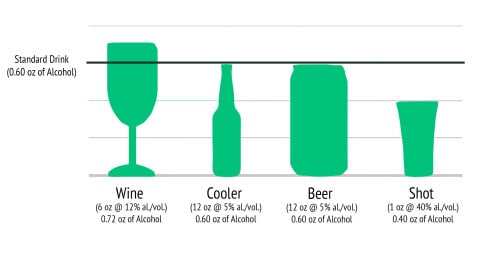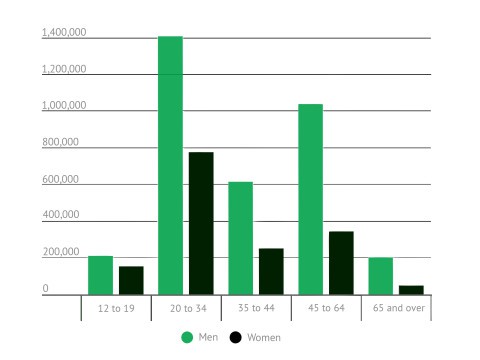Alcohol is an accepted — even expected — part of student life. Too often, though, students aren’t aware of when a bit too much is really way too much.
Alcohol and teenagers go hand in hand in popular TV shows, movies and songs. Life reflects art, so Canadian teenagers are exposed on a daily basis to lyrics and scripts that imply alcohol is a necessity to properly enjoying their youth. Is it any wonder that once these teenagers reach university age they’re having trouble regulating their alcohol consumption?
Take some recent popular song lyrics as examples. In ILoveMakonnen’s recent dance hit “Tuesday,” the lyrics imply and glorify exactly what you’d expect — clubbing and drinking in the middle of the week. Luke Bryan’s current chart-topping single “Kick the Dust Up” references moonshine and beer multiple times.
When these artists sing about drinking with fast-paced beats and slick instrumentals, it sounds awesome. There aren’t any consequences to this alcohol-infused lifestyle — just parties, sex and great friends.
Well, time for a reality check. Consumption of alcohol, especially among young adults whose brains are not finished developing until their mid 20s, can be damaging to health, mental capabilities and social relationships. Most students understand that drinking in excess can be unhealthy, but the problem is that many students have different ideas of what “in excess” means.
During an informal survey in Place Riel, the Sheaf asked students about their opinions on what is too much alcohol consumption per week for a student. The results were varied.
“Drinking more than once a week,” said Maggie Sutherland, first-year arts and science student.
“Three times a week is too often,” said Brittany Preston, second-year pharmacy student.
“Depends on what classes you have, but five times is a lot,” said Zac Olson, first-year arts and science student.
“Every weekend is too much,” said Jennifer Ackerman, second-year education student.
The students surveyed obviously had their own ideas, but Canada’s Low-Risk Alcohol Drinking Guidelines say that women should have no more than 10 drinks every week and men no more than 15. “No more than two per day,” says the guideline, and many students surpass this. The risks of doing so are nothing to brush off easily.
Health Canada also warns that excessive alcohol use can lead to liver cirrhosis and cancer. Additionally, brain development can be severely delayed by alcohol use.
It’s hard to know though when to step in and intervene with our friends’ alcohol use — or our own. Students at the University of Saskatchewan had thoughts on this matter as well. The Sheaf asked: What aspects of a friend’s behaviour would make you worry they have a problem with alcohol?
“If they’re drinking by themselves, at home, that’s going to be a red flag,” said David Anaka, first-year engineering student.
“If they do something they wouldn’t do when not drinking, it would be like — hold up,” said Naveen Elemary, first-year arts and science student.
“If they had a problem and their solution was drinking,” said Brittany Preston, second-year pharmacy student.
“Aggressive behavior or just being by themselves a lot,” said Christina Thachuk, fourth-year commerce student.
“If they are drinking alone — and not just one, if they are having a bunch alone. And maybe if they are hungover for school or work on a regular basis,” said Brett Martens, second-year agronomy student.
“Every time they drink, they pass out,” said Francis Sicat, second-year commerce student.
These are warning signs, but they are different from clinical symptoms. According to the Canadian Centre on Substance Abuse’s guide for alcohol use, increased tolerance and withdrawal symptoms after going without alcohol are diagnostic indicators of alcohol dependency. Natural tolerance depends on a lot of factors, including genetics and body weight. Also, whether a person has recently eaten affects how quickly alcohol processes within their body.
Student life glorifies the ability to “hold your liquor,” but high tolerance can actually mean a person is drinking too much, too often. Those with high tolerances are also at a higher risk for developing an addiction.
Somehow, though, binge drinking is accepted and idolized on university campuses everywhere. It can feel difficult to break away from that norm, when everyone around is drinking and popular weekend gatherings often involve heading to a bar or club.
When asked how he thought being a non-drinker would affect his social life, Martens seemed to think it would have an impact.
“You could still go to the same events but just not drink; you could meet the same people, but it probably would affect things a bit because some people want that in a friend if they drink,” Martens said.
Students seeking some guidance about their alcohol intake can turn to the U of S student-run initiative What’s Your Cap?, whose slogan is “Know when to put a lid on drinking.” Colleen Dell, research chair in Substance Abuse at the U of S, helped several of her students establish the campaign in January 2011 with the aim of educating  students on responsible, healthy enjoyment of alcohol.
students on responsible, healthy enjoyment of alcohol.
Maddy Huggins is a fourth-year sociology student and also the project coordinator of What’s Your Cap? She spoke to the Sheaf about the relationship between university students and alcohol.
“Many students believe that in order to engage in the social components of university, they have to drink, or drink excessively,” Huggins said. “Knowing what a standard-sized drink is is important so you can measure your alcohol intake.”
Huggins explained that What’s Your Cap? aims to help students figure out what a healthy relationship with alcohol looks like for them as individuals.
“Many students report drinking to relieve stress, so it is really good to find alternative stress relievers such as working out, painting, playing sports, going for walks or bike rides, spending time with family… whatever may help!” Huggins said. “University is a stressful time and often over-consuming alcohol results in additional stress rather than relieved stress.”
What’s Your Cap? was so successful initially that it now has a large presence on campus, with a booth at Welcome Week and a home base in lower Saskatchewan Hall that students can visit to learn more and get involved.
Dell and her team published a research paper about What’s Your Cap? in September 2015 in the Yale Journal of Biology and Medicine.
The paper states that a large number of students engage in high-risk binge drinking at Canadian universities and then goes on to present some startling statistics.
Forty per cent of students surveyed admitted to regretting their activities while drinking and 30 per cent had memory blackouts. Blackouts happen when blood alcohol content goes up too high, too quickly. As a response, the body stops recording memories, rendering the drinker unable to recall the narrative of their activities.
The liver can metabolize roughly one drink per hour. Anything above this affects the rest of the body, including the brain. Memory loss is coupled with loss of coordination, inability to speak clearly and sometimes passing out or vomiting. It’s the body’s response to being slowly poisoned.
In extreme cases, overindulgence in alcohol can lead to irreversible poisoning — too much for the liver to deal with in time to stop those other symptoms. It is also heavily correlated with deaths resulting from accidents, vehicular or otherwise. In their 2011 report, Statistics Canada found Saskatchewan to be tied with Prince Edward Island for having the highest number of impaired driving incidents.
These are scary facts. Alcohol abuse and dependency are real threats to students. That isn’t to say, however, that alcohol can’t be enjoyed in a healthy, fun manner. It’s about awareness and honesty — how much is too much, and how often? Have I had too many drinks to get behind the wheel of a car? Are any of my friends exhibiting warning signs that I should be open with them about before brushing them off as typical student behaviors? Am I hurting myself and laying down patterns of alcohol use that could turn into dependency? These are all important questions for students to consider.
Alcohol can be fun — there’s nothing wrong with having beers with friends, toasting a beautiful dinner with a glass of wine or buying your friend a shot at the bar and hitting the dance floor. If alcohol becomes a need rather than a want, however, it might be time to reach out to organizations like What’s Your Cap? or check in with U of S Health Services to find information on how to mediate a habit before it becomes an addiction.
—
Images: Jeremy Britz/Graphics Editor